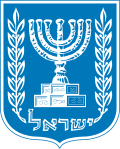
Back Gusch Emunim ALS غوش إيمونيم Arabic جوش ايمونيم ARZ Gush Emunim Catalan Guš emunim Czech Gusch Emunim German Guŝ Emunim Esperanto Gush Emunim Spanish گوش امونیم Persian Goush Emounim French
Gush Emunim גּוּשׁ אֱמוּנִים | |
|---|---|
 | |
| Leader | Zvi Yehuda Kook (1974-1982) |
| Governing body | Hanan Porat Moshe Levinger Shlomo Aviner Menachem Froman Yoel Bin-Nun Yaakov Ariel |
| Founder | Zvi Yehuda Kook Haim Drukman |
| Founded | February 1974 |
| Succeeded by | Yesha Council |
| Armed body | Jewish Underground |
| Settlement body | Amana |
| Political party | National Religious Party |
| Ideology | Neo-Zionism Religious Zionism Jewish messianism Jewish fundamentalism Halachic state Settler interests |
| Religion | Orthodox Judaism |
| State of Israel |
|---|
 |
Gush Emunim (Hebrew: גּוּשׁ אֱמוּנִים, lit. "Bloc of the Faithful") was an Israeli ultranationalist[1] religious Zionist[2] Orthodox Jewish[3] right-wing fundamentalist activist[2][4] movement committed to establishing Jewish settlements in the West Bank, Gaza Strip, and the Golan Heights.[5] Gush Emunim, as of 2010, had never been formally disbanded,[6] but it has nevertheless officially ceased to exist.[7][page needed]
While not formally established as an organization until 1974 in the wake of the Yom Kippur War, Gush Emunim sprang out of the conquests of the Six-Day War in 1967, encouraging Jewish settlement of the land of Israel based on two points, one religious and one practical. The religious point was a belief that, according to the Torah, God wants the Jewish people to live in the land of Israel and had returned lands such as the biblical Judea and Samaria as an opportunity for the Jewish people to return to their ancestral homeland.[8][9] The second point stemmed from a concern that the pre-1967 borders, a mere 10 km (6.2 mi) wide at its narrowest point, were indefensible, especially in the long term, and it was therefore necessary to ensure that the land captured in the Six-Day War remained under Israeli control by creating a Jewish presence in the region and placing "facts on the ground".[10][9] While Gush Emunim no longer exists officially, vestiges of its influence remain in Israeli politics and society.[7][11]
- ^ "World: Two Standards of Justice". Time. 21 August 1978. Retrieved 5 June 2022.
High on a hilltop above the valleys of the West Bank, 35 families belonging to Israel's ultranationalist Gush Emunim are building a new settlement named Beth-El. They claim that 120 Jewish families are waiting to move into the settlement, nine miles north of Jerusalem, in territory that Israel has occupied since the 1967 war. There are plans for schools, a religious study center, an industrial area and even a holiday resort.
- ^ a b Aran, Gideon (1991). "Jewish Zionist Fundamentalism: The Bloc of the Faithful in Israel (Gush Emunim)". In Marty, Martin E.; Appleby, R. Scott (eds.). Fundamentalisms Observed. The Fundamentalism Project, 1. Chicago, Il; London: University of Chicago Press. pp. 265–344. ISBN 0-226-50878-1.
- ^ Sprinzak, Ehud (2013). "From Messianic Pioneering to Vigilante Terrorism: The Case of the Gush Emunim Underground". In David C. Rapoport (ed.). Inside Terrorist Organizations. Routledge. pp. 194-215 [see 194]. ISBN 1135311781. Retrieved 25 April 2025.
- ^ Kedem, Peri; Bilu, Amos; Cohen (Lizer), Zila (March 1987). "Dogmatism, Ideology, and Right-Wing Radical Activity". Political Psychology. 8 (1). International Society of Political Psychology: 35–47. doi:10.2307/3790985. JSTOR 3790985. Retrieved 25 April 2025.
- ^ Sprinzak, Ehud (16 September 1986). "Fundamentalism, Terrorism, and Democracy: The Case of the Gush Emunim Underground". Archived from the original on 28 June 2004. Originally presented for discussion at a colloquium at The Wilson Center on 16 September 1986.
- ^ Taub, Gadi (2010). The settlers: and the struggle over the meaning of Zionism. New Haven: Yale University Press. doi:10.12987/9780300168631. ISBN 978-0-300-16863-1. OCLC 806012532. S2CID 246119479.
- ^ a b Allen, Katherine (15 June 2005). "The Ideological Resonance of Zionist Fundamentalism in Israeli Society" (PDF). Archived from the original on 16 March 2012. Retrieved 28 February 2013.
{{cite web}}: CS1 maint: bot: original URL status unknown (link) Final paper in Behavioral Sociology of Identity Conflict, Spring 2005, at the School of Advanced International Studies, Johns Hopkins University. - ^ Analyses of Gush Emunim have been carried out by David Newman. See:
- D. Newman, "Gush Emunim", Encyclopaedia Judaica Decennial Yearbook, 1994, pp. 171-172, Keter Publishers.
- D. Newman, "Gush Emunim: Between Fundamentalism and Pragmatism", Jerusalem Quarterly, 39, 1986, pp. 33-43.
- Newman, David (2005). "From Hitnachalut to Hitnatkut: The Impact of Gush Emunim and the Settlement Movement on Israeli Society". Israel Studies. 10 (3): 192–224, 204. doi:10.1353/is.2005.0132. ISSN 1527-201X. S2CID 35442481..
- See also T. Hermann & D. Newman, "Extra Parliamentarism in Israel: A Comparative Study of Peace Now and Gush Emunim", Middle Eastern Studies, 28 (3), 1992, pp. 509-530.
- ^ a b Klein Halevi, Yossi (2020) [2013]. "Like Dreamers". In Yehuda Kurtzer; Claire E. Sufrin (eds.). The New Jewish Canon. Emunot: Jewish Philosophy and Kabbalah. Academic Studies Press. pp. 221–226. doi:10.2307/j.ctv1zjg9h6.40. JSTOR j.ctv1zjg9h6. Retrieved 25 February 2022.
- ^ "Israel – Geography". U.S. Library of Congress.
- ^ Encyclopaedia Judaica: Volume 8, p. 145
© MMXXIII Rich X Search. We shall prevail. All rights reserved. Rich X Search